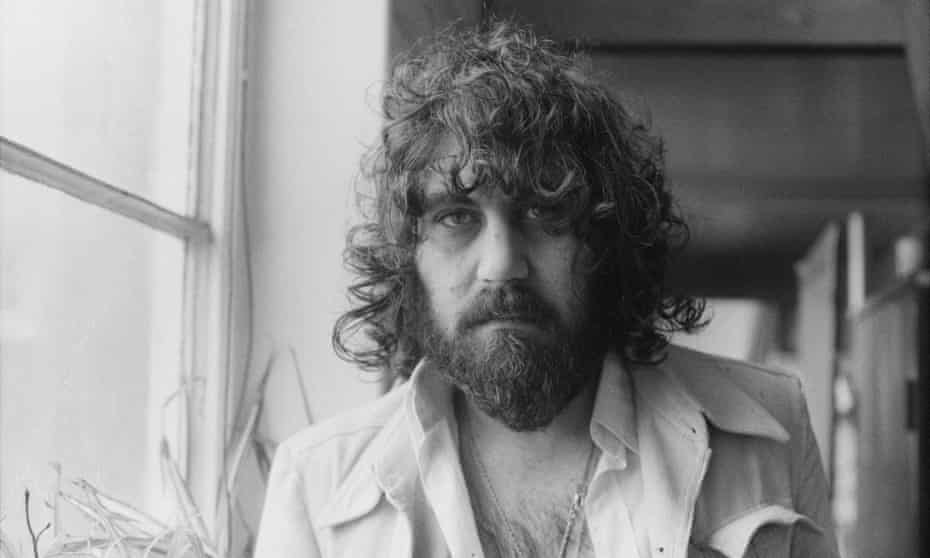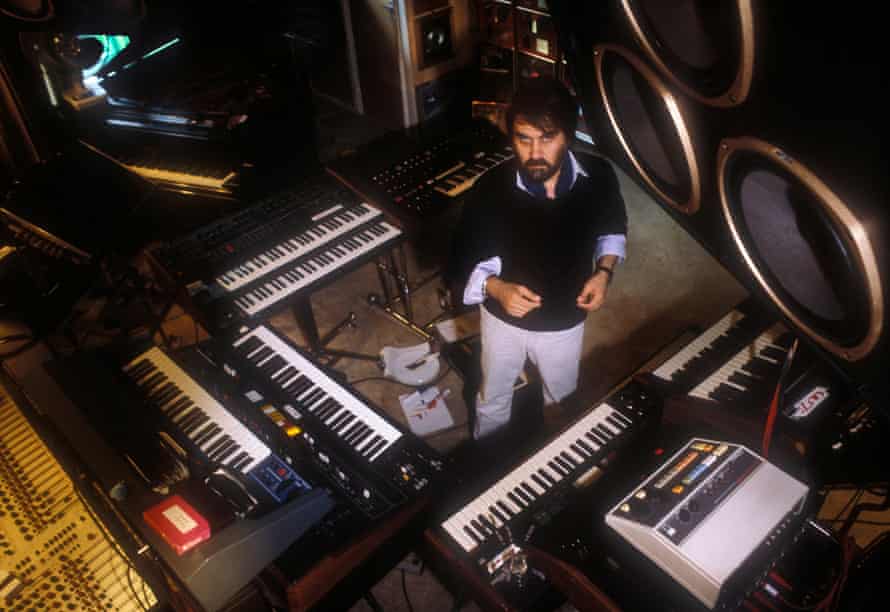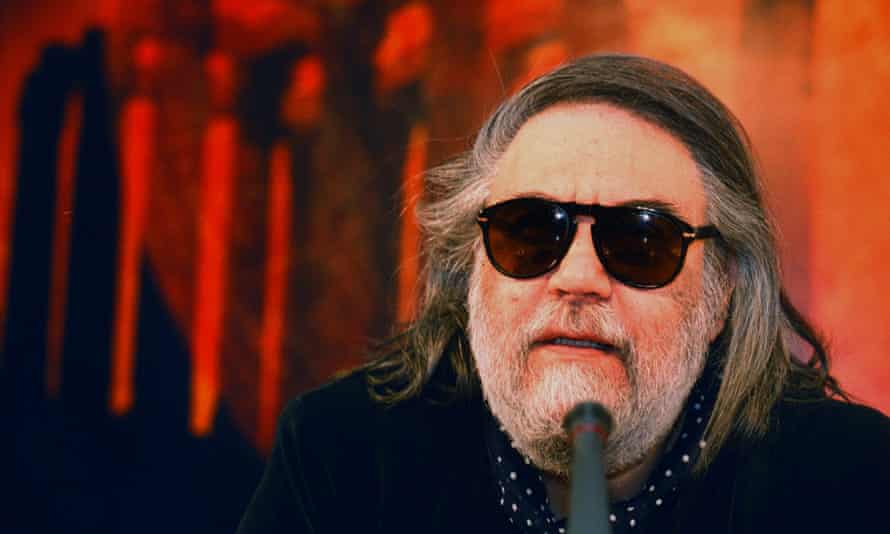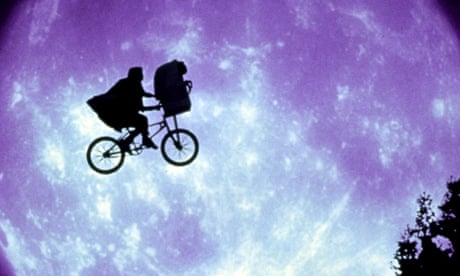RIP
Bob Neuwirth, Folk Singer-Songwriter Who Had Profound Impact on Bob Dylan, Dead at 82David Browne
Thu, May 19, 2022,

Bob Neuwirth (right) performs with Bob Dylan and the Rolling Thunder Revue at a benefit concert for boxer Rubin Hurricane Carter, January 1976. - Credit: AP
One day in 1970, a young Patti Smith was sitting in the lobby of the Chelsea Hotel in New York, working on her poetry, when a familiar-looking figure approached her. “He came up to me and asked me if I was a poet,” she tells Rolling Stone of the figure in trademark dark glasses she immediately recognized from a Bob Dylan documentary. “I knew exactly who he was. He looked like he’d stepped out of Don’t Look Back, which I’d seen about 100 times. He said, ‘Let me see what you’re writing.’ He started reading and he was one of the first people who looked at my work and took it seriously. He said, ‘You should be writing songs.’”
The figure was Bob Neuwirth, the folk singer-songwriter and painter who influenced or impacted on a wide range of artists, including Smith, Bob Dylan, and Janis Joplin. Neuwirth died Wednesday at age 82 in Santa Monica, California, according to his partner, Paula Batson, who confirmed the death to Rolling Stone.
More from Rolling Stone
Bob Dylan: An Intimate Biography, Part Two
On the Road With Bob Dylan, Joan Baez and the Rolling Thunder Revue
“On Wednesday evening in Santa Monica, Bob Neuwirth’s big heart gave out,” Neuwirth’s family said in a statement. “Bob was an artist throughout every cell of his body and he loved to encourage others to make art themselves. He was a painter, songwriter, producer and recording artist whose body of work is loved and respected. For over 60 years, Bob was at the epicenter of cultural moments from Woodstock, to Paris, Don’t Look Back to Monterey Pop, Rolling Thunder to Nashville and Havana. He was a generous instigator who often produced and made things happen anonymously. The art is what mattered to him, not the credit. He was an artist, a mentor and a supporter to many. He will be missed by all who love him.”
Throughout his multi-decade career, Neuwirth moved back and forth between the worlds of music and art, largely and happily under the radar, although his connections with classic rock made him a legend. Dylan fans remember him for his caustic cameos in Don’t Look Back, director D.A. Pennebaker’s movie of Dylan’s 1965 U.K. tour, as well as Neuwirth’s appearances in the 1975 Rolling Thunder Revue tour. Joplin fans recognize him by way of her a cappella classic “Mercedes Benz,” which the two co-wrote with poet Michael McClure. In the private-collector art world, Neuwirth was renowned for exhibitions of his paintings, and Velvet Underground diehards recall his Nineties work with John Cale. Neuwirth also introduced Joplin to “Me and Bobby McGee,” written by his friend Kris Kristofferson; Joplin recorded the song just days before her 1970 death.
“When you’re around people like that, you’re not driven to be a musician,” Neuwirth said in 1989 of his collaborations. “I had other outlets. I was a painter, so it never occurred to me to do any of those other things.”
“He was good at everything,” says Smith. “He was a great songwriter. A moving singer. A really fine painter. He had so much magnetism; you couldn’t not be drawn to him. But it wasn’t because he was aggressive. He just wasn’t the kind of person who pushed own agenda on a situation.”
Born in Akron, Ohio, on June 20, 1939, Neuwirth first attended Ohio University before moving to Boston in 1959 to attend the School of the Museum of Fine Art on an arts scholarship. After a side trip to Paris, he returned to Boston, working in an art supply store and learning to play banjo and guitar, which led him to become part of the early Sixties Cambridge folk scene. “Painting is how I got into folk music, in a way,” he said in 1989. “I sort of put myself through art school as a folk singer. It was always my secondary art, and my part-time job.”
Neuwirth began visiting the similar scene developing in New York’s Greenwich Village (partly, he once joked, because the weed was more readily available). At one point in a club there, he met Dylan, with whom he shared a caustic, cutting sense of humor and hipster persona. “Right from the start, you could tell that Neuwirth had a taste for provocation and that nothing was going to restrict his freedom,” Dylan wrote in Chronicles Volume 1. “He was in a mad revolt against something. You had to brace yourself when you talked to him.” Dylan also referred to Neuwirth as “a bulldog.”
Eventually, Neuwirth became part of Dylan’s tight inner circle, hanging out at bars like the Kettle of Fish in the Village and trading barbs with whoever was in sight. As one singer who played with Dylan told Rolling Stone in 1972, “Neuwirth was a scene maker, a very strong cat. When he got to New York in 1964, he started hanging around Dylan. And Dylan started to change at that time. Part of it was Neuwirth, he was a real strong influence on Dylan. Neuwirth had a negative attitude, stressing pride and ego, sort of saying, ‘Hold your head high, man, don’t take shit, just take over the scene.’ He was the kind of cat who could influence others, work on their egos and support those egos. His whole negative attitude fell in perfectly with what Dylan was feeling.”
Neuwirth moved to L.A. soon after, where he remained for most of his life afterwards. In 1974, after years playing clubs, he finally released a record of his own, Bob Neuwirth, on David Geffen’s Asylum label. The album – which set Neuwirth’s craggy voice to freewheeling, sometimes boozy honky-tonk – wasn’t a commercial hit. But it was a cult favorite, and plans to reissue it were in the works when Neuwirth died. (The project is currently scheduled for release next year.)
In addition to Don’t Look Back, Neuwrith also co-starred in Dylan’s experimental 1978 film Renaldo and Clara. That film also featured many of the artists in Dylan’s Rolling Thunder Revue, an ensemble Neuwirth is credited with helping to assemble. (Neuwirth’s 1975 shows at the Other End in the Village became a gathering point for many of the participants on that tour.)
For Joan Baez, who met Neuwirth on the Cambridge folk scene, Neuwirth could be a stabilizing figure when she found herself out of sorts in Dylan’s world, starting with the tour immortalized in Don’t Look Back. “When we were on that tour, I was feeling horrible and Bob [Neuwirth] wanted me to go home,” he says. “He said, ‘It’s not going to get any better.’ And it didn’t. But Neuwirth was right.” A decade later, during the Dylan-led Rolling Thunder shows, Baez was feeling similarly out of sorts. “I felt slighted again, which is how I spent much of my time with Dylan,” she says. “I had taken to my bed in my hotel and Neuwirth came in and started acting silly and opened the window and shouted, ‘She’s going to live!’ He was just one of those people who could make you laugh.”
The painting work he had started in the early Sixties continued. Early in his career, he produced what were called “quirky hybrids of Cubism and Surrealism.” Later, he concentrated on wall works that incorporated painting and sculpture. A major exhibit of his work, Overs & Unders: Paintings by Bob Neuwirth: 1964 – 2009, took place in Los Angeles in 2011.
Although his music career was never his priority, Neuwirth dipped back into that part of his life intermittently. Starting with 1989’s beautifully spare Back to the Front, he resumed making occasional, wry and often stark country-folk records. With John Cale, whom he’d met during their time hanging out at Andy Warhol’s Factory in the Sixties, he made 1994’s Last Day on Earth, which Neuwirth described as “an abstract Prairie Home Companion.” In 1995, Mercedes Benz licensed Joplin’s song for a high-profile commercial. “I wonder what took them so long,” Neuwirth cracked at the time. (Of the song, which was quickly written between sets of a Joplin show, he said, “It was a throwaway, a fluke. I wouldn’t call it songwriting.”) Neuwirth also produced two albums for Texas singer-songwriter Vince Bell.
In 2004, Neuwirth served as emcee of Great High Mountain, a bluegrass and Americana tour inspired by the success of O Brother, Where Art Thou? and featuring Alison Krauss, Ralph Stanley and others. In recent years, he also participated in tribute concerts to Randy Newman and the late folklorist Harry Smith, as well as a 2018 New York concert recreating Dylan’s 1963 show at Town Hall. The latter was especially noteworthy since Neuwirth normally distanced himself from his Dylan associations, rarely giving interviews about that period in his life.
“Like Keruoac had immortalized Neal Cassady in On the Road, someone should have immortalized Neuwrith,” Dylan wrote. “He was that kind of character … With his tongue, he ripped and slashed and could make anybody uneasy, also could talk his way out of anything. Nobody knew what to make of him. If there was ever a renaissance man leaping in and out of things, he would have to be it.”
For Smith, the cover of Dylan’s Highway 61 Revisited — which shows Neuwirth, but only as a pants-wearer standing behind Dylan — spoke to his understated but important role in the culture. “That’s him in a nutshell,” she says. “He stays in the background. But he’s there, and his presence is always strong.”
Additional reporting by Daniel Kreps
Bob Neuwirth, Folk Figure of 1960s and Beyond, Influence on Bob Dylan and Co-Writer of ‘Mercedes Benz,’ Dies at 82
Chris Willman
Thu, May 19, 2022

Neuwirth is seen above in a photo taken just two weeks ago by Larry Bercow.
Bob Neuwirth, a recording artist, painter, mainstay of the New York City folk scene in the 1960s, and a collaborator with Bob Dylan, Janis Joplin, John Cale and T Bone Burnett, among others, died in Santa Monica Wednesday night at age 82. The cause of death was heart failure.
“On Wednesday evening in Santa Monica, Bob Neuwirth’s big heart gave out,” said his longtime partner, entertainment executive Paula Batson, in a statement. “He was 82 years old and would have been 83 in June. Bob was an artist throughout every cell of his body and he loved to encourage others to make art themselves. He was a painter, songwriter, producer and recording artist whose body of work is loved and respected.
More from Variety
New Bob Dylan Center in Tulsa Might Just Be the GOAT of Rock Museums
Bob Dylan's Share of Traveling Wilburys Acquired by Primary Wave Music (EXCLUSIVE)
25 Fun Things to Seek Out at the Bob Dylan Center: His Times, They Are A-Curated
“For over 60 years, Bob was at the epicenter of cultural moments from Woodstock, to Paris, ‘Don’t Look Back’ to Monterey Pop, ‘Rolling Thunder’ to Nashville and Havana. He was a generous instigator who often produced and made things happen anonymously. The art is what mattered to him, not the credit. He was an artist, a mentor and a supporter to many. He will be missed by all who love him.”
Neuwirth took on many roles in his career in the arts, in and out of music, but Patti Smith may have encapsulated it best when, in her memoir, she described him as “a catalyst for action.”
In his memoir, “Chronicle: Volume 1,” Dylan wrote, “Like Kerouac had immortalized Neal Cassady in ‘On the Road,’ somebody should have immortalized Neuwirth. If ever there was a renaissance man leaping in and out of things, he would have to be it.”
In 1988, writing the liner notes for a Neuwirth album, T Bone Burnett took stock of Neuwirth’s place in the scene and called him “the best pure songwriter of us all.”
Neuwirth was not prolific in the albums he released over a 60-year career, often preferring work as a painter or supporting other artists’ visions as a producer, writer or bandleader, although he had resumed concert performances in recent years. In 1994, he and John Cale collaborated on the experimental album “Last Day on Earth,” on MCA. His series of solo albums began with a self-titled 1974 effort on Asylum.
He did not record a sophomore album for another 14 years, finally reemerging with “Back to the Front,” the 1988 album that included the aforementioned Burnett liner notes, made with Steven Soles, another veteran of the Rolling Thunder Revue. In the late ’90s, Neuwirth went to Havana and worked with famed Cuban musician Jose Maria Vitier on their album “Havana Midnight.”

Bob Neuwirth - Credit: John Byrne Cooke
Being part of Bob Dylan’s circle led to a certain kind of fame among that artist’s vast army of fans. Neuwirth is seen in the film “Don’t Look Back,” standing alongside Allen Ginsberg in the background of the “Subterranean Homesick Blues” proto-music-video. And he helped assembled the band for — and performed on — the Rolling Thunder Revue tour in the mid-’70s, which led to his also being featured in Dylan’s “Renaldo and Clara” film. In-between, he had toured with his close friend Kris Kristofferson.
Neuwirth was interviewed for both of Martin Scorsese’s Dylan documentaries. “Back then it wasn’t money-driven,” Neuwirth says in the 2005 film “No Direction Home.” “It was about if an artist had something to say. Whether it was Bob Dylan or Ornette Coleman, what people would ask was, ‘Does he have anything to say?'
Among the things that help make up Neuwirth’s legend is that he co-wrote one of Janis Joplin’s most iconic songs, “Mercedes Benz,” for the singer shortly before her 1970 death. It became a posthumous hit and one of the songs she is most identified with – as well as a shower song for millions in her wake. “It’s a campfire song, isn’t it?” Neuwirth told this writer in a 2013 interview. “You don’t need any particular musical skill to sing it, and because it’s a cappella, everybody can tackle it in their own way. But I’m sure Janis would be shocked at the attention that that song has gotten over the years. She’d just be shaking her head in disbelief at it.”
In another unpublished interview, Neuwirth said, “Mercedes Benz’ came when Janis and I were both drunk between shows, and she just played it and people loved it. It was put onto her ‘Pearl’ album. They needed a filler because she hadn’t recorded enough for the album before she died.” Neuwirth was also responsible for introducing Joplin to the signature song “Me and Bobby McGee,” written by Kristofferson.
As the Coen brothers’ “O Brother, Where Art Thou?” took off and generated a wave of enthusiasm for early 20th century roots music, Neuwirth rejoined D.A. Pennebaker, the director of “Don’t Look Back,” to co-produce the documentary “Down From the Mountain” filmed at the Ryman Auditorium in Nashville with the artists who made the music for the “O Brother” soundtrack. Neuwirth was the musical director on the concert tour that followed.
As his work continuing the impact of the “O Brother” music on the road and on film would indicate, Neuwirth was a close associate of T Bone Burnett from the Rolling Thunder Revue period onward. He co-wrote songs on the early albums of Peter Case, which Burnett produced.
In the late ’90s Neuwirth worked with the late Hal Wilner on the Harry Smith Anthology all-star concerts that were documented as they took place at the Royal Festival Hall in London, St. Ann’s Church in Brooklyn and UCLA’s Royce Hall. He also contributed a song to Wilner’s all-star 2006 compilation “Rogue’s Gallery: Pirate Ballads, Sea Songs and Chanteys.”
In 2014-16, Neuwirth had developed a “Stories and Songs” show that he took to New York, Los Angeles and the Country Music Hall of Fame and Museum in Nashville. When Neuwirth went to the latter museum in 2018 for “Music Masters: A Conversation with Bob Neuwirth,” museum editor Peter Cooper wrote, “Neuwirth’s path has been less a line than a hodgepodge of glorious zig-zags, all existing within a giant circle of song…Whether in spite of or because of the hijinks, hokum and hell, Neuwirth’s music stands as a testament to a marvelous, rollicking life.”
Of the wide range of forms his work took, Neuwirth said, “It’s all about the same to me, whether it’s writing a song or making a painting or doing a film. It’s all just storytelling.”
Neuwirth was born in the Akron, Ohio area and began painting as a teenager, which eventually led him to the School of the Museum of Fine Art in Boston. After spending time living in Paris and soaking up classical art there, he returned to Boston and worked in an art supply store while learning how to play guitar and banjo. He became part of the Cambridge folk scene that included Joan Baez, Geoff Muldaur and others, soon performing in New York, Berkeley and San Francisco as well. He joined Dylan for the tour captured in “Don’t Look Back.” But he continued to keep his focus largely on visual art, moving to New York and becoming part of the scene that would convene at Max’s Kansas City, a group that included Andy Warhol, Larry Poons, Robert Smithson and Robert Raushenberg.
In 2011, his artwork, which had long been solely the province of private collectors, was exhibited at the Track 16 Gallery in Santa Monica in a show curated by Kristine McKenna titled “Overs & Unders: Paintings by Bob Neuwirth, 1964-2009.” The notes for that exhibition said that in the early ’60s, “he was producing quirky hybrids of Cubism and Surrealism. The ’70s found him exploring various experimental materials, and he went on to produce a series of wall works that straddled the zone between painting and sculpture, and a cycle of haunted landscapes that are poised between abstraction and figuration. Neuwirth’s work has grown increasingly lyrical and fluid over the course of his career, and in recent years he’s been producing exuberant, expansive pictures filled with space, light, and blazing color.”
In an interview with the Paris Review, Neuwirth said, “I know how people can get famous. They have to tickle the G-spot of their minds. But being anonymous is so much more powerful. You can get so much more done if you’re not worried about fame and fortune. You can get a lot done.”
Neuwirth is survived by Batson and his niece, Cassie Dubicki, and her family.












